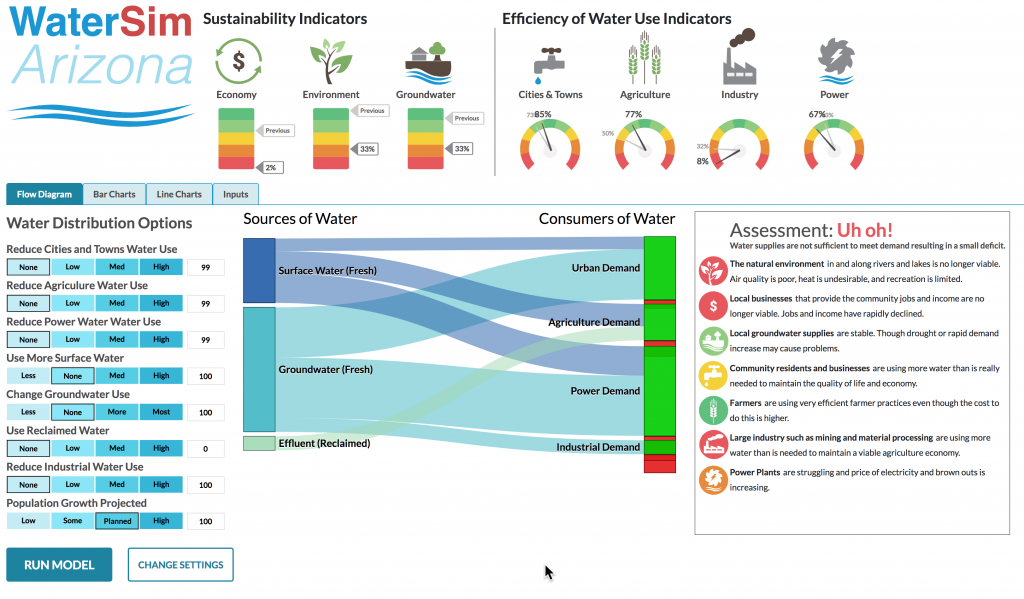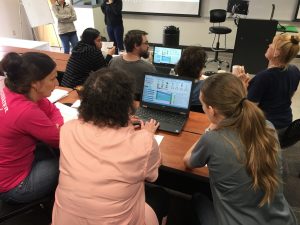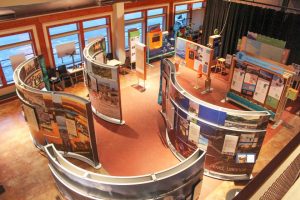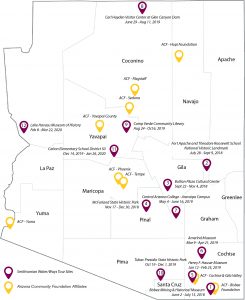WaterSim Arizona is a web browser-based user interface to a water balance model that mimics the water supply and water use dynamics for five distinct regions of the state of Arizona. WaterSim Arizona utilizes the WaterSim West model but is focused just on the regions in Arizona: North, West, Central North (Verde Valley), Central South (Phoenix Regions), and Southeast.
WaterSim Arizona is delivered to the public in two ways. First, as an exhibit displayed through an iPad Pro within the Water/Ways Arizona exhibition. Second, as a web browser-based classroom version available to teachers for implementation in their classroom.

Acting as a water manager, users may manipulate management policies pertaining to the water availability and use specifics associated with each region. This may include increasing the efficiency of water use by urban and rural water users, increasing or reducing the use of surface or groundwater, or other policies that are relevant to your local area. In this interactive game, your objective as a water manager gaming to optimize the water supply and demand projections for your region, is to bring into balance the various water users found in your region. Of course, there is no one answer because individuals, and regions, have different opinions about what they envision as a sustainable water future.
We have included help files in the interface to answer questions about the various policies, outputs from the simulation, and sustainability indicators—a snapshot that graphically displays how sustainable your choices are—to guide you in managing your water resources.
Engaging Teachers with WaterSim Arizona and Smithsonian’s WaterStories

Past generations created our current water systems, but new generations will need to develop building blocks for future water sustainability. Today, rural areas are struggling with water issues yet research shows rural youth lack connections to local history and a sense of belonging and engagement.
DCDC, Smithsonian’s Museum on Main Street, Arizona Humanities and Arizona Community Foundation have created a platform of education and engagement for grades 7-16 which will engage youth in conversations about their communities.
Rural Arizona Water Education Project
Supported by a grant from the Ellis Center for Educational Excellence of the Arizona Community Foundation, DCDC is reaching out to grade 7-16 teachers to participate in our training on a STEM tool called WaterSim Arizona and a humanities experience called WaterStories. In conjunction with Arizona’s two-year tour of Smithsonian’s Water/Ways exhibition, our training will provide rural teachers with tools to integrate sustainable water issues into standard-based classroom activities.
In the classroom, WaterSim Arizona will provide a unique hands-on, state-of-the-art immersive visualization modeling tool to understand the complexity of water sustainability in Arizona. Using WaterStories, students can express personal stories about water in their culture and communities.
The one-day training includes:
- Learn the basics of water supply and demand in your Arizona region.
- Learn how the WaterSim Arizona model works and the curriculum which can be used by teachers and students.
- Learn about the humanities tool WaterStories.
- Learn how to use video and audio equipment to collect student WaterStories.
- Receive WaterSim Arizona curriculum.
- Receive printed materials for classroom use.
DCDC is offering stipends to middle, high school, and community college teachers to integrate WaterSim Arizona and WaterStories into their classroom curriculum.
- $500 stipend to cover teacher’s time for training and classroom planning.
- $500 stipend to teachers who implement WaterSim Arizona in their classroom.
- $500 stipend to teachers who implement WaterStories in their classroom.
Classroom Resources
- ASU DCDC Arizona Water 101
- WaterSim Arizona Model for the Classroom
- ASU DCDC WaterSim Arizona Classroom Curriculum
- ASU DCDC WaterSim Arizona Companion Presentation
- ASU DCDC WaterStories Guide
- Smithsonian’s Museum on Main Street Storytelling Toolkit
Links
Water/Ways Exhibition – A Smithsonian Institution Collaboration with Arizona Humanities
Water/Ways Exhibition

The Smithsonian’s Water/Ways exhibition dives into water–an essential component of life on our planet, environmentally, culturally, and historically.
In societies across the globe, water serves as a source of peace and contemplation. Many faiths revere water as a sacred symbol. Authors and artists are inspired by the complex character of water – a substance that is seemingly soft and graceful that is yet a powerful and nearly unstoppable force.
Water also plays a practical role in American society. The availability of water affected settlement and migration patterns. Access to water and control of water resources have long been a central part of political and economic planning. Human creativity and resourcefulness provide new ways of protecting water resources and renewing respect for the natural environment.
Water/Ways Arizona Exhibition Host Sites

- June 2-July 15, 2018 | Bisbee Mining and Historical Museum, Bisbee, AZ
- July 28-September 9, 2018 | Fort Apache and Theodore Roosevelt School National Historic Landmark, Fort Apache, AZ
- September 22-November 4, 2018 | Bullion Plaza Cultural Center and Museum, Miami, AZ
- November 17-December 30, 2018 | McFarland State Historic Park, Florence, AZ
- January 12-February 25, 2019 | Henry F. Hauser Museum, Sierra Vista, AZ
- March 9-April 21, 2019 | Amerind Museum, Dragoon, AZ
- May 4-June 16, 2019 | Central Arizona College-Aravaipa Campus, Winkelman, AZ
- June 29-August 11, 2019 | Carl Hayden Visitor Center at Glen Canyon Dam, Page, AZ
- August 24-October 6, 2019 | Camp Verde Community Library, Camp Verde, AZ
- October 19-December 1, 2019 | Tubac Presidio State Historic Park, Tubac, AZ
- December 14, 2019-January 26, 2020 | Canon Elementary School District 50, Black Canyon City, AZ
- February 8-March 22, 2020 | The Lake Havasu Museum of History, Lake Havasu City, AZ
Project Funding
With long-term funding from the National Science Foundation, numerous faculty and staff have studied, modeled and adapted Watersim Phoenix into WaterSim Arizona.
Leveraging our work in the Phoenix metropolitan area training teachers on WaterSim Phoenix, principal investigator, Ray Quay, submitted a grant application to the Arizona Community Foundation to extend our training to the state of Arizona with “Rural Arizona Water Education: Creating Opportunities with Smithsonian’s Water/Ways and DCDC’s WaterSim.”
Arizona Community Foundation Grant

The Rural Arizona Water Education project is supported by a grant from the Ellis Center for Educational Excellence of the Arizona Community Foundation. Established in 1978, the Arizona Community Foundation is a statewide philanthropic entity supported by thousands of Arizonans. Last year, ACF and its affiliates awarded more than $40 million in grants and scholarships, funding projects of some 3,000 nonprofit organizations, schools and government agencies. Visit Arizona Community Foundation.

